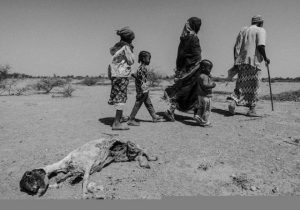‘No time to lose’ as humanitarian catastrophe looms in Somalia – UN agencies
It should be winter on the Arctic pole – the northern most point in the world – but the equivalent of heatwaves have passed over the region this season melting the sea ice volume to a record low in January, the United Nations meteorological agency said. “Temperatures in the Arctic are quite remarkable and very alarming,” said David Carlson, Director of the World Climate Research Programme which is co-sponsored by the UN World Meteorological Organization (WMO), the UN Educational, Scientific and Cultural Organization (UNESCO) and the International Council for Science. Sea ice extent was the lowest on the 38-year-old satellite record for the month of January, both at the Arctic and Antarctic, according to data cited WMO from both the US National Snow and Ice Data Center (NSIDC) and Germany’s Sea ice Portal operated by the AlfredWegener-Institut. The Arctic sea ice extent averaged 13.38 million square kilometres in January, according to NSIDC. This is 260,000 square kilometers below the level in January 2016 – an area bigger than the size of the United Kingdom. “The recovery period for Arctic sea ice is normally in the winter, when it gains both in volume and extent. The recovery this winter has been fragile, at best, and there were some days in January when temperatures were actually above melting point,” said Mr. Carlson. “This will have serious implications for Arctic sea ice extent in summer as well as for the global climate system. What happens at the Poles does not stay at the Poles.” In addition, the ice levels at the Antarctic are also at record lows, even thinner than expected for the summer season there. A polar bear in Svalbard, a Norwegian archipelago located between mainland Norway and the North Pole. Photo: UNEP GRID Arendal/Peter Prokosch ‘No time to lose’ as humanitarian catastrophe looms in Somalia – UN agencies 17 February – Amid worsening of an already devastating drought in Somalia, United Nations agencies have underlined that only a massive and immediate scale-up of humanitarian assistance can help the country avoid falling into another catastrophe. According to the United Nations Children’s Fund (UNICEF) and the UN World Food Programme (WFP) some 6.2 million people – almost half the country’s population – are either severely food insecure or in need of livelihood support. “Huge numbers of Somalis have come to the end of all their possible resources and are living hand-to-mouth,” said Steven Lauwerier, the UNICEF Somalia Representative, underlining that there is only a small window of opportunity to arrest the looming humanitarian crisis and save lives. The situation of children is particularly concerning: close to one million children are estimated to be malnourished this year, including 185,000 severely malnourished and in need of urgent lifesaving support. There are also grave fears that this number could increase to 270,000 over the coming months. The ongoing drought and other shocks have left communities – that have already been battered by decades of conflict – with little to no resources to fall back on, the two UN agencies said in a joint news release. Whole villages have lost their crops or seen their livestock die. The prices of water and locally produced food have risen dramatically, and thousands of people are on the move in search of food and water. The drought has also led to an increase in waterborne diseases with more than 4,000 cases of Acute Watery Diarrhoea/Cholera this year. “Humanitarian assistance has saved lives in the drought-affected north over the past year, but as the crisis spreads we have no time to lose,” added WFP Country Director Laurent Bukera, noting that together with its partners, the UN agency is “moving as quickly as possible” to reach people with lifesaving support. The two agencies further noted that humanitarian access remains conqueringly limited in some drought-affected areas of the south, but that WFP and UNICEF are reinforcing their joint efforts to scale up the response in areas that are accessible, where millions of lives are at risk. The agencies have been responding together to the drought by providing food and water vouchers to hundreds of thousands across the most affected areas of Somalia as well as nutrition assistance. As additional resources are mobilised, the joint response will continue to expand in the most vulnerable regions. However, with growing needs, more funds are needed. UNICEF and WFP together still require more than $450 million to be able to provide urgent assistance required in the coming months.
Source:UN
